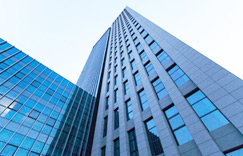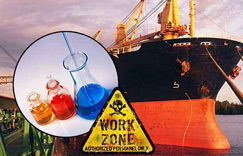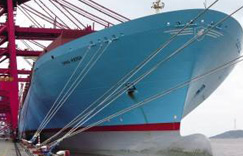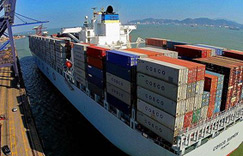The world's largest automated terminal is equipped with brains "made in China"
2021-05-26 17:05
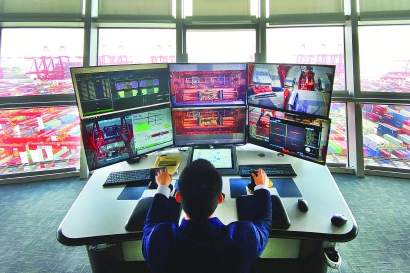
Shanghai Yangshan Phase IV Automated Terminal is currently the world's largest automated container terminal, and its loading, unloading and transportation all use self-developed intelligent systems. Photo by reporter Zhao Lirong
Awards: 2020 Shanghai Science and Technology Progress Award Special Prize
Project Name: Research and Application of Key Technologies of Yangshan Phase IV Super-large Automated Container Terminal
Award-winning team: SIPG, Tongji, Shanghai Jiaotong University, Zhenhua Heavy Industry, China Communications Third Aviation Academy
After driving over 30 kilometers of Donghai Bridge, you will arrive at the world's largest single automated intelligent terminal and the world's most comprehensively automated terminal-the fourth phase of Yangshan Port. There are almost no workers in the open air except for the driver who issues the card. Under the automated operating system dispatch, the container is unloaded from the ship to the transfer platform by a double trolley quay crane, and all horizontal transportation is completed by an unmanned automatic guided vehicle. More than 60,000 magnetic nails are buried in the entire terminal to locate the vehicle. And automatic navigation...
Since the opening of the port in December 2017, the production efficiency of the Yangshan Phase IV Terminal has repeatedly set world records: the highest quay-hour capacity of the quay crane is as high as 57.4 natural containers; the day and night throughput reaches 20,823.25 standard containers; the production operations have achieved intrinsic safety and direct emissions. Zero, and the per capita labor productivity is 213% of that of the traditional terminal.
Such an efficient and green port operation capability relies on ITOS, an intelligent operation management and control system. On the 2020 Shanghai Science and Technology Awards list announced yesterday, this set of key technologies that marked the milestone upgrade and major changes in the operation mode and technology application of China's port industry won the special prize of the Science and Technology Progress Award.
"Made in China" software realizes the most efficient "stacking of boxes"
"Oriental Southampton remaining work volume 2342" "Modern Dublin time schedule 60.39%", on the huge screen in the control room of the Yangshan Phase IV terminal, the terminal's digital twin system displays everything from moored ships to automated guided vehicles in real time dynamic.
With seven berths, the Yangshan Port Phase IV terminal can berth professional container ships of up to 200,000 tons. "Our promise to our customers is that the loading and unloading of 5000 TEU freighters can generally be completed within 16 to 24 hours." Huang Xiusong, director of the Technology Center of Shanghai International Port (Group) Co., Ltd., introduced that the most important business of the terminal is "box stacking". ": After unloading, do I need to transfer or enter customs? How to arrange the order of shipment? ...This is a great test for data collection and calculation processing.
Huang Xiusong said frankly that after about a year of research, demonstration, and comparison of foreign terminal management software, they finally decided to develop independently. I have never done dock automation software, everything is explored from scratch, this is the biggest difficulty encountered by the project. After nearly ten years of polishing, the fourth phase of Yangshan Port has become the only "China Core" automated terminal in China, and it is also the only domestic automated terminal whose software system is purely "Made in China".
In the past, only one item of container loading required an experienced loading engineer who took three or four hours to complete. Now, from the moment the ship enters the terminal, the demand will be automatically entered into the ITOS, and the system will automatically generate the most efficient solution that enables the entire terminal to work together according to the operation of the terminal.
Dockers changed from "blue collar" to "quasi-white collar"
Handling more than 20,000 TEUs day and night, loading and unloading operations are extremely busy, but the entire terminal is very quiet. The quay cranes on the sea side have all realized automatic remote control, and the rail cranes used on the land side of the yard have also realized automatic loading of containers. Only due to the micro-movement of the ship and the shaking of the quay crane spreader, the quayside crane side of the container “grabs it at the door” requires the cooperation of man and machine to complete.
In the past, operators were sitting in the crane control room at a height of 50 meters, leaning down to operate the container, and the working environment was difficult. Now, the fourth phase of Yangshan has realized automatic remote control. The operator can sit in the control room and simply press the button or push the handle remotely according to the real-time information displayed on the screen. “It can be said that automation has changed the working environment, turning dockers from'blue-collar' to'quasi-white-collar'.” Said Fang Huaijin, vice president of SIPG. The current equipment scale and workload, such as traditional terminal operation management, foreign At least more than 700 workers are required in the Phase IV of the Mountain; now, only more than 100 people directly participate in the remote operation of the equipment in the entire terminal.
In addition to remote control, there are a large number of unmanned automated guided vehicles that replace the trucks that "run errands". For the first time, Yangshan Phase IV adopted China's self-developed automatic guided vehicle and automatic power exchange system for the first time in Asian ports. These self-developed trolleys have no head and no tail, and can transport containers to their destinations under the guidance of magnetic nails buried in the ground. Moreover, the battery replacement of these cars only takes 6 minutes, and the battery is fully charged in only 2 hours. The entire charging process has zero emissions, which can save energy consumption by more than 40%.
The "brain" is autonomous and controllable and can be continuously upgraded
Independent and controllable, ITOS can continuously improve and surpass itself with the development of Yangshan Phase IV Terminal.
In the past ten years, in response to ship shaking and other problems, the project team has innovated and developed technologies such as AI perception of physical three-dimensional characteristics of front and rear tasks, and high-precision automatic twisting control of equipment to achieve real-time perception of box position and precise control of spreader status. Improve terminal operating efficiency by about 20%. In order to fundamentally solve the problem of intelligent operation management and control system in the field of automated terminal technology, SIPG took the lead in undertaking the key special common key technology projects of the national key research and development plan "Networked Collaborative Manufacturing and Smart Factory", and initiated the implementation of the "big data-driven ultra Research and development of intelligent operation management and control technology for large container terminals.
It is expected that by 2022, the project will complete the upgrade of China’s first super-large automated container terminal intelligent operating system with fully independent intellectual property rights, and promote the operation efficiency of the terminal to be greatly improved again, and achieve a further increase of the overall quay crane average platform time efficiency by more than 10% , The annual handling capacity of the single terminal is further increased by more than 50%-this means that the annual handling capacity of Yangshan Phase IV will exceed 6 million boxes.

